The Consumer node is a node where the management goal is maximizing payment output success in both pathfinding and in payment size and will focus on outbound liquidity. Someone who is using Lightning to live a sovereign bankless lifestyle will most likely need a Consumer Node. This article will cover the options of running your node, channel strategy, payment success, remote access, and more.
Let’s get started. Your first decision is how would you like to deploy your node. These are the most popular options:
Option #1: Run your node on hardware at home, such as on a Raspberry Pi.
Pros:
Cons:
Option #2: Run your node on a VPS Service Platform such as Voltage.
Pros:
Cons:
Option#3: Mobile Lightning Wallet without a Node (Muun, Phoenix, etc.)
Pros:
Cons:
If you choose Option #1 or #2, continue reading! Let’s get your node set up!
Basic Channel Configuration
Now that you have your node setup you must decide how much capital you are going to allocate to your first channels and decide how you will be using your node. For example, if you plan on buying a lot of gift cards from Bitrefill, consider opening a channel to Bitrefill. If you plan on making general payments to multiple services/merchants, then consider opening channels to the well-connected routing nodes on the network.
If you plan to use Bitrefill frequently, not only will having a direct channel with Bitrefill basically guarantee successful payments to them, but it would reduce routing fees you might have to pay if you had to route a payment through the wider network over multiple hops. The downside to this is that Bitrefill over time may be able to deduce that your node is owned by your Bitrefill account name. There is no way for them to know for sure, though.
The next step is to determine how much capital you want to use for your channels. This is important because every channel open incurs an on-chain fee, so if you plan on buying a $200 Amazon gift card from Bitrefill every week, then maybe open a channel worth $1000 or more, so you can get multiple gift cards out of one channel over time.
You can open channels directly to services that you are likely to use often. But what about access to the wider network? You should consider opening up more channels to other nodes on the network to increase your reach. The size of these channels will differ from person to person, but it’s important to think through the best plan to minimize on-chain fees. You do not want to have to open a channel each time you make payment.
Every channel that you open will not have any inbound liquidity. But since your plan is to buy stuff rather than receive, this is not a big deal. Over time as you spend, your channel balance will shift towards the inbound side which will allow you to receive payments if you wish to do so.
Unannounced vs. Announced Channels
When you open a channel you must decide if you are going to announce the channel to the wider network. This is called a public channel. If you choose not to announce the channel, it is called a private channel. The major difference is that an announced channel can be seen by the entire network, including total capacity, peers, and fee rate.
This information is then used by the network to forward other payments through your channel so you can earn a fee. If you have no desire to route other peoples’ payments, consider opening an Unannounced channel. An Unannounced channel can only be seen between the two peers that the channel is between, and not the wider network. This channel will not be able to forward the payments of others and thus you cannot earn fees on this channel.
When you are opening a channel with Thunderhub, click the Advanced options for the ability to toggle between Public and Private. A channel type cannot be changed after opening so be sure you set it correctly.
Privacy Note
When using the Lightning Network, it is important to know that if you generate an invoice for someone else in the traditional sense (known as BOLT 11 invoicing), you are telling them the end destination of the payment, which means they may be able to tie your identity to your node ID. Do not send an invoice to a party that you do not want to know the alias and pubkey of your node.
If you are making a payment, the end recipient will only know the last hop of the payment, and not who is actually paying. This is important because you must decide if you want to give away certain information about your node to the node being paid. If you decide to open unannounced channels, it may be good practice to keep all channels unannounced on your node so the outside network cannot gauge your node’s total capacity.
To sum this up, use unannounced (private) channels so that you do not tell the wider network the total capacity of your node and reduce the chance of your node being tied to your real-life identity. Be careful when sending BOLT 11 invoices to third parties, as that would be giving them the information necessary to possibly tie your identity to your node.
Maximizing Payment Successes
While I won’t go into intricate detail on how to maximize your payment success, there are a few tips that are relatively easy to do and will increase your success rate dramatically.
First, connect to other well-connected nodes. For further tips on finding well-connected nodes, check out other Voltage blogs: Why are my Lightning Payments Failing and the node operator series.
Second, ensure the nodes you are connecting to have an average channel size that you deem appropriate for your needs. For example, there may be a node out there you want to open a channel with. They may have 50+ channels, high centrality to the wider network, and high ranking…but what if their average channel size was very low? Like 500,000 sats? And you are looking for higher throughput. They may not be a good peer for your needs. Always do your research on Amboss, Terminal Web, and other tools.

In the above image, the Orange is the balance of the channel that you can send. As your spend funds from your channel (the top image), the channel will increase on the inbound side(shown in the bottom channel. Your receive capacity is the inbound side, and the send capacity is the outbound side.
Remote Access
Now that you have some channels open, you can sit at your computer and buy gift cards or maybe other stuff with paywithmoon or TBC visa gift cards. Awesome. But how do you access your node when on the go?
There is an open-source app called Zeus that is built for this very purpose. You can download it from an app store or an .apk and then remotely access your node to make or receive payments while on the go. If you are using Voltage, you can also log in to your voltage dashboard when on the go, but the Zeus app makes this even easier. Zeus also supports TOR, which is a bit slower but also a more private connection option.
What to Do With Excess Inbound Liquidity
As you continue to spend using your Lightning Node, your channel balance will flow from the outbound side to the inbound side. When your channel reaches maximum inbound, you can no longer spend from it, because your spendable sats have depleted. Now you have a heavy inbound channel, so what can you do with it?
First, you can receive funds. Maybe you sell a batch of cookies to your neighbor. You can now generate an invoice and receive payments since you have the inbound liquidity to do so. What you can also do is sell that inbound liquidity. How does this work?
Essentially you offer a channel to a prospective peer for a price. After they pay you, you open a channel to them. This can be done on marketplaces such as Amboss Magma and Lightning Pool. Okay, you just got paid and opened a channel to your customer. Now what? Presumably, the person who bought your liquidity is going to use it for accepting payments. That is one of the primary reasons someone would need inbound liquidity. As that liquidity moves from the outbound to the inbound side of that channel, your other channels outbound will increase, because each forward payment your node does moves your channel balances to stay in balance.
You could also just spend out of the channel you opened yourself if you like. If you would rather not earn a yield in this way, you can simply close the inbound heavy channels to keep your node more in line with your goals.
Summary
Living on Bitcoin has never been easier. You can pay your bills with bitcoin on Bitrefill, top up your google or apple-pay with paywithmoon, or buy gift cards with The Bitcoin Company. As the Lightning Network continues to grow, it becomes easier and easier to slowly opt out of the traditional banking structure. As a global and permissionless network, the Lightning Network is being positioned to be a huge disruption to the traditional merchant and consumer payment rails. By learning how to run a node now, you are a pioneer. Never stop learning and enjoy every moment of it!




